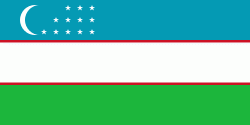Samarkand
 |
By the time of the Persian Achaemenid Empire, it was the capital of the Sogdian satrapy. The city was conquered by Alexander the Great in 329 BCE, when it was known as Markanda, which was rendered in Greek as Μαράκανδα. The city was ruled by a succession of Iranian and Turkic rulers until it was conquered by the Mongols under Genghis Khan in 1220. Today, Samarkand is the capital of Samarqand Region and a district-level city, that includes the urban-type settlements Kimyogarlar, Farxod and Xishrav. With 551,700 inhabitants (2021), it is the second-largest city of Uzbekistan.
The city is noted as a centre of Islamic scholarly study and the birthplace of the Timurid Renaissance. In the 14th century, Timur (Tamerlane) made it the capital of his empire and the site of his mausoleum, the Gur-e Amir. The Bibi-Khanym Mosque, rebuilt during the Soviet era, remains one of the city's most notable landmarks. Samarkand's Registan square was the city's ancient centre and is bounded by three monumental religious buildings. The city has carefully preserved the traditions of ancient crafts: embroidery, goldwork, silk weaving, copper engraving, ceramics, wood carving, and wood painting. In 2001, UNESCO added the city to its World Heritage List as Samarkand – Crossroads of Cultures.
Modern Samarkand is divided into two parts: the old city, and the new city, which was developed during the days of the Russian Empire and Soviet Union. The old city includes historical monuments, shops, and old private houses; the new city includes administrative buildings along with cultural centres and educational institutions. On September 15–16, 2022, the city hosted the 2022 SCO summit.
The name comes from Sogdian samar "stone, rock" and kand "fort, town." In this respect, Samarkand shares the same meaning as the name of the Uzbek capital Tashkent, with tash- being the Turkic term for "stone" and -kent the Turkic analogue of kand.
Map - Samarkand
Map
Country - Uzbekistan
 |
 |
| Flag of Uzbekistan | |
The first recorded settlers in what is now Uzbekistan were Eastern Iranian nomads, known as Scythians, who founded kingdoms in Khwarazm (8th–6th centuries BC), Bactria (8th–6th centuries BC), Sogdia (8th–6th centuries BC), Fergana (3rd century BC – sixth century AD), and Margiana (3rd century BC – sixth century AD). The area was incorporated into the Iranian Achaemenid Empire and, after a period of Macedonian rule, was ruled by the Iranian Parthian Empire and later by the Sasanian Empire, until the Muslim conquest of Persia in the seventh century.
Currency / Language
| ISO | Currency | Symbol | Significant figures |
|---|---|---|---|
| UZS | Uzbekistan som | so'm or Ñўм | 2 |
| ISO | Language |
|---|---|
| RU | Russian language |
| TG | Tajik language |
| UZ | Uzbek language |















